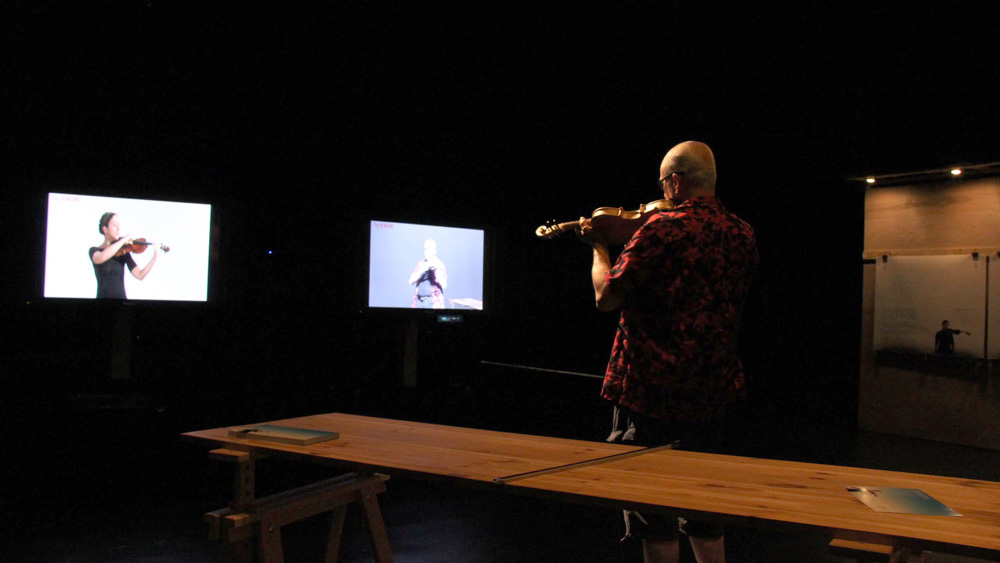It’s not often that the seriousness of formal music education blends with the pleasure of gaming. But that’s precisely what happens in The Violin Lesson, a collaborative work by artist Lorraine Oades, musician Brigitte Dajczer and programmer Patrice Coulombe. The work premiered in English this summer at Concordia University’s Hexagram Black Box—an especially appropriate venue that aims to bring together works bridging fine arts, science, engineering and computing—and a French-language version is currently in production for exhibitions elsewhere.
In The Violin Lesson, classical-music training meets Guitar Hero. This interactive installation invites the public to learn how to play the violin with the assistance of multimedia technology.
Upon entering a dimly lit exhibition space, motion-capture software activates two large flatscreen monitors which show Dajczer performing a duet of a classical Persian song. On the left screen, Dajczer plays her own instrument, and on the right, she uses a handmade one that Oades meticulously crafted out of plywood. On a table sits the plywood violin and, further back, large-scale prints related to the piece.
When a viewer picks up the violin and plucks its strings, their image is instantly projected onto the right-hand screen and the lesson automatically begins. Dajczer, appearing on the left screen, demonstrates how each note ought to be executed, prompting the participant to play along with her. The video clips include coloured graphics which help guide learners through 14 lesson chapters.
As the lesson progresses, barriers between the violin, the software program and the viewer break down; any sense of confusion or apprehension quickly turns to focus and enjoyment. From one part of the lesson to the next, the bowing technique increases in complexity, the finger movements get faster, and the range of pitch that the program will accept becomes narrower so that the notes must be played with greater accuracy.
On occasion—like when viewers are prompted to repeat a part of the lesson in order to move on—keeping up with this constant rise in difficulty might prove arduous, even slightly frustrating. At other times, however, it feels exhilarating and provides a great sense of accomplishment.
The Violin Lesson seamlessly blends the art of teaching with that of learning while synthesizing digital archives and live human presence, effectively mirroring our time, which is abundant in online courses and YouTube tutorials. Yet paradoxically, in its tactile, audiovisual and performative aspects, this piece not only acts to emphasize our sense of embodiment, but also to remove us from a specific and unified standpoint. Through projection, one’s existence is doubled: as we act in the concrete, analog world we can likewise watch our own duplicated self in an artificial, digital reality, participating in a half-simulated duet.
Furthermore, The Violin Lesson defies traditional ways of connecting with art by making an elite-status instrument more approachable to the uninitiated public. The sheer fact that Oades built a violin out of plywood confuses distinctions between precious and common objects, blurring the lines that separate “high” from “low” culture, and perhaps reduces the gap that too often divides the rich from the poor.
In this respect, The Violin Lesson‘s enterprise is somewhat reminiscent of the Recycled Orchestra of Cateura. Located in a poverty-stricken municipality of Paraguay, this orchestra consists of young students, led by director Favio Chavez, who play classical music on functional instruments created out of garbage. Though the Recycled Orchestra is an extreme example, both it and The Violin Lesson, at their core, share a vision of artistic enablement, didactic guidance and a spirit of democratic accessibility.
It is also crucial to note that The Violin Lesson is a project that embraces collaboration from its inception to its articulation within the public sphere.
In terms of inception, this installation brings together expertise from Oades, an artist who uses a DIY approach to modify existing devices with contemporary technology; from Dajczer, a professional violinist and media artist known for performing a hybrid Balkan, Roma and Southeastern European music; and Coulombe, an artist and musician who is also a leading Montreal programmer.
With regards to execution, The Violin Lesson is contingent upon the public taking an active role and becoming key in the making of its meaning. This collaborative piece encourages the visitor to step outside of their comfort zone and engage with an interactive computer program and a classical musical instrument. It establishes a two-way street between producer and consumer, allowing the visitor to be involved in the creative process. Moreover, the experience of engagement in itself becomes generative and transformational: in order to “get it,” one must choose to be a part of it.
And there is something here for us to bring back into the real world as well. Beyond the mere act of learning a song on the violin, this project inspires us to stretch our own creative capacities by trying something new. Touching on the intimacy, vulnerability and sense of discovery that playing a musical instrument can bring to our lives, The Violin Lesson challenges our need for immediate gratification and encourages us to be less concerned about failure.
Ultimately, The Violin Lesson teaches us that it may be best to risk playing badly than not playing at all.









